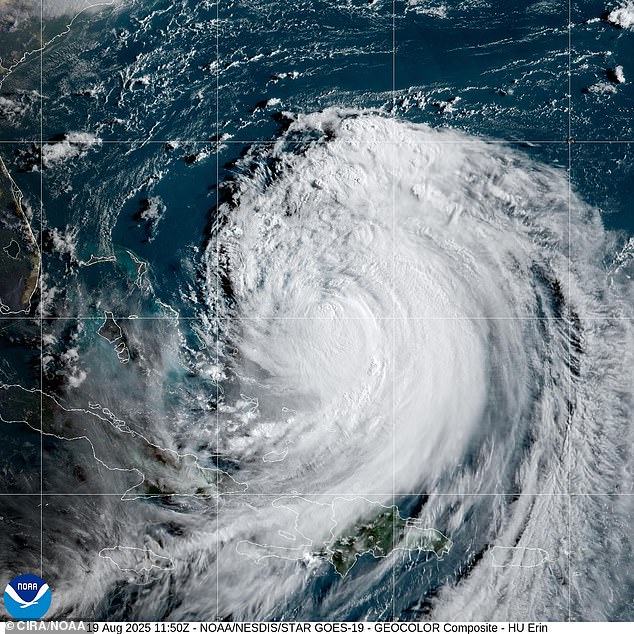Millions of Americans are being urged to prepare as Hurricane Erin moves up the East Coast over the Atlantic Ocean.
Although the storm is not expected to make landfall, North Carolina, South Carolina, Georgia, Virginia, New Jersey, New York and Massachusetts are facing significant coastal threats.
Hatteras Island in North Carolina has been evacuated ahead of the hurricane, and the Outer Banks have declared a state of emergency.
Flood warnings are in effect through Thursday for parts of Georgia, North Carolina, and South Carolina, with two to seven inches of rain expected.
Erin is set to generate towering 20-foot waves and dangerous rip currents along the East Coast, even while tracking roughly 200 miles offshore.
The National Hurricane Center warned Tuesday morning that tropical storm conditions and coastal flooding are possible in the North Carolina Outer Banks starting late Wednesday, and strong winds could impact the Mid-Atlantic and southern New England through Friday.
Beachgoers and coastal residents are urged to follow guidance from lifeguards, local authorities and posted warning flags.
Forecasters said Erin is growing in size, with hurricane-force winds extending up to 80 miles from the center and tropical-storm-force winds stretching 205 miles, putting more areas at risk.

Hurricane Erin was about 665 miles southwest of Bermuda and 720 miles south-southeast of Cape Hatteras on Tuesday morning, moving northwest at a slow 7mph
In Georgia, flood warnings affect Burke, Emanuel, Jenkins and Screven counties.
Central and eastern North Carolina, including Edgecombe County and the Outer Banks, face flash flooding with two to six inches of rain.
South Carolina’s coastal and low-country regions, including Charleston and Horry counties, are under warnings, worsened by saturated soils and potential storm surge.
New Jersey currently has no active coastal flood advisories, but heavy rainfall and potential storm surge continue to pose a risk.
A high danger of rip currents is in effect for all beaches through Wednesday evening.
Waves are expected to rise from four to six feet today, eight feet by Wednesday and 10 to 12 feet by Thursday.
Several towns, including Wildwood, have closed beaches, while Avalon temporarily closed a road due to wind-driven waves.
South-facing Long Island beaches, along with Cape Cod and Nantucket in Massachusetts, could see six- to nine-foot waves near shore and 12 to 15 feet offshore, with dangerous rip currents and minor tidal flooding.

Puerto Rico experienced major flooding due to teh storm, which forecasters warn could be the same for several US states over the next few days

Hatteras Island in North Carolina has been evacuated ahead of the hurricane, and the Outer Banks have declared a state of emergency
Southeast Virginia, including Norfolk and Virginia Beach, is at risk of moderate coastal flooding.
Early Tuesday, an Air Force Reserve Hurricane Hunter plane measured winds of around 111 mph in Erin’s center.
Combined with satellite data, forecasters estimate winds of about 115 mph, though the NHC cautions this may be slightly generous.
‘There are mixed signals on Erin’s future intensity,’ the NHC said. ‘More favorable environmental shear and upper-level divergence in 24–36 hours could allow some re-intensification, but Erin’s slow motion and large size may bring cooler water to the surface, limiting significant strengthening.’
One key update is that Erin continues to grow in size, with tropical-storm-force winds now extending closer to the Mid-Atlantic and southern New England coasts later this week.

Beachgoers and coastal residents are urged to follow guidance from lifeguards, local authorities and posted warning flags
The hurricane was about 665 miles southwest of Bermuda and 720 miles south-southeast of Cape Hatteras on Tuesday morning, moving northwest at a slow 7mph.
A tropical storm warning remains in effect for the Turks and Caicos Islands, where government services have been suspended, some ports closed, and residents ordered to stay home.
Residents along the East Coast are urged to stay alert over the coming days as heavy surf, rip currents, and coastal flooding continue to threaten life and property.
This article was originally published by a www.dailymail.co.uk . Read the Original article here. .

